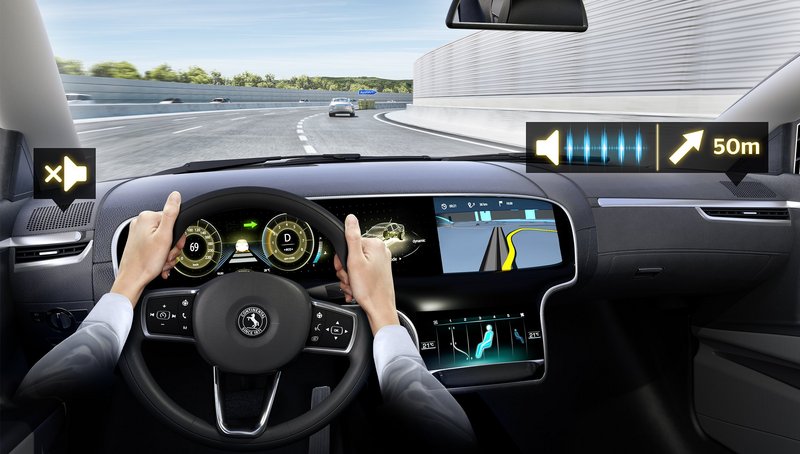Central Audio Management by Continental Gives Drivers an Audible Driving Experience
- Another step towards the holistic human-machine interface: software integrates and prioritizes all sound sources inside the vehicle
- Spatial audio output supports drivers and guides their attention to the right place in complex situations
- Customer-specific modifications of all system sounds and a reloadable audio scheme provide a personalized brand experience
- Plug-in-based system incorporates all desired sound algorithms, even from third parties
Wetzlar, October 17, 2016. Turn signals, parking assist, navigation instructions, audible alerts, incoming messages and telephone calls -cars today are equipped with a multitude of sound sources. These alerts and sounds have typically been controlled independently of each other. As a result, prioritizing sounds across domain boundaries or using sounds in addition to their intended functions has been virtually impossible, until now. The international technology company Continental has developed a Central Audio Management system that integrates all audible sources in a vehicle in one single system. In doing so, Continental is opening up brand new possibilities for carmakers when it comes to the design of the holistic human-machine interface. For example, audio management can be used to specifically focus the attention of the driver. If a source of danger, such as another vehicle, approaches from the right, an audible warning signal sounds from the right-hand side of the vehicle, while all other sounds are faded out. This solution enables the creation of individual audio schemes within the vehicle, including the prioritization and intensification of existing sounds. As an example, when a person walks behind the vehicle the audible alert could be louder than the alert when approaching a stationary object.
One element of central hardware used for the integration of the various sound sources is the Integrated Interior Platform, which ensures a seamless flow of information in the vehicle in its capacity as a control center.
"With central audio management, we are developing the holistic human-machine interface further and extending it on an audible level,” said Johann Hiebl, head of the Continental Infotainment & Connectivity business unit. “By using spatial sound to audibly guide drivers, we are helping them focus in traffic and assess critical situations."
First ones and zeros, then warnings and sounds
Alongside central audio management, another essential function is the software's live data connection. This means that the system can be connected to driver assistance systems or cloud applications, such as the eHorizon from Continental and create or modify sounds based on the data received. This is known as sonification or auditory display. Converting data into sound can help drivers when navigating. As an example, when a vehicle approaches a turn the indication alert increases in speed, notifying the driver when to make the turn. They no longer have to read the distance indicator or estimate distance information. Turning is also made easier by spatial audio output of directions. The instruction to turn comes from the direction in which the vehicle should drive. This enables drivers to keep their attention on the road in stressful driving situations, such as in urban traffic in an unfamiliar area, and to better understand navigation instructions. Thanks to the spatial audio output, the sound source can move around the vehicle almost freely and be played from any available speakers, or can be used to guide the attention of the driver. By doing so, the driver is able to deviate the audible location accuracy by up to eight angular degrees. The significance of the modified audio output also becomes clear in other situations. For instance, the sound of the turn signals can be augmented with additional information. If the driver initiates an overtaking maneuver and uses the turn signal, it effectively becomes a blind spot assistant, whereby the sound of the indicator is overlaid with an audible warning. The sound of the turn signal only returns to normal when the lane is free, meaning that the driver can change lanes after checking over their shoulder. As a result, drivers do not have to spend time looking for gaps in passing traffic and can focus their attention on the vehicle in front of them. The collision warning works in a similar way. Thanks to the live data connection, the system could even be informed about vehicles around the corner and immediately sound a spatial audible alert to inform the driver of a potential collision.
"Both warning modes of our functional audio system enable drivers to hear the traffic. We are shaping human-machine communication to be more intuitive thus ensuring improved safety for all road users," said Hiebl.
Sound tuning for individual sound experiences
For the first time, Continental’s Central Audio Management system allows the audio design to be adapted across the entire system and vehicle, which can be automatically controlled by the vehicle sensors. By making it possible to integrate sound algorithms from all major manufacturers any available effects can be assigned to the sound output. As a result, carmakers are creating new sound functions to provide their customers with an individual, brand-specific audio experience. The system offers a variety of customization options for drivers who want to add that personal touch to their environment, enabling them to download and playback sounds at any time. Whether the various sounds for non-safety-functions in a vehicle include birds chirping, snippets from a favorite song, or science fiction sound effects from box-office hits, they can be completely tailored to the driver's tastes.
Sound algorithms from third parties, such as noise cancellation or 3D sound, can also be integrated as a plug-in. All functions and settings can be configured using a development tool with a graphical user interface. This allows developers to simulate the sound design and even test and modify the settings in real time in the target vehicle. This reduces the development time for sound effects, ensuring greater efficiency.
A holistic sound experience – not only for premium class vehicles
It goes without saying that the central audio management system also includes all of the conventional functions. For instance, it can stream content from mobile devices and prioritize sound playback. This means hardware modifications are not required and the software can be controlled by the head unit, for example. Although certain functions benefit from high-quality, multichannel speaker systems, the system basically works if a vehicle has two speakers – meaning it is not limited to premium class vehicles. In addition to the connection to external sources such as the cloud, end customers can add new functions in the form of apps via updates provided by secure remote access.

Sebastian Fillenberg
Head of External Communications
Continental Automotive



